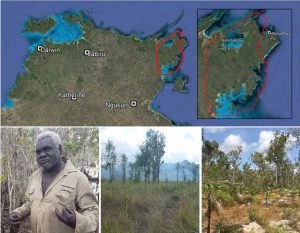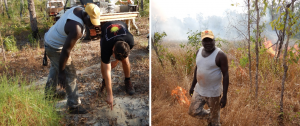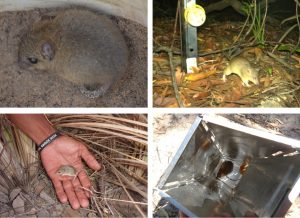by Banul Munyarryun, Ben Kitchener, Gill Towler, Yirralka Rangers, Emilie Ens
In June 2018, Yirralka Senior Ranger Banul Munyarryun, a respected cultural leader of north east Arnhem Land’s Dhalinybuy community, welcomed Macquarie University staff and other Yolŋu (NE Arnhem Aboriginal people) onto his country. This was the second collaborative, cross-cultural biodiversity survey conducted in the Laynhapuy IPA under the Australian Government Citizen Science program (Citizen science project builds on award winning cross-cultural collaboration in eastern Arnhem Land) in partnership with the Atlas of Living Australia. The project aims to fill gaps in biodiversity knowledge of remote Arnhem Land by combining western science and technologies with local Aboriginal people’s complex understanding of their country. Through the surveys we are particularly targeting small mammal species, such as native rodents and dasyurids, that have been decimated across northern Australia by feral animal invasion and altered fire regimes.

The survey team was introduced to the survey location, Nyiknyikpuy, by Banul. In Yolŋu Matha, a simple translation of Nyiknyikpuy is ‘place of small rodents’. Banul explained that his clan group, the Wangurri, hold many cultural stories of this country. These traditional stories hold important information, and as they are passed through generations, they carry knowledge of the effective ecological and spiritual management of country.
One such story is of the nyiknyik (general Yolŋu term for native rodents), held by Wangurri, which is part of a songline that runs through Nyiknyikpuy and surrounding country. It explains the behaviours of rodents after the country is burnt by local people, as told by Banul:
“The nyiknyik is a totem for Wangurri… When we burn fire this is by song, Wangurri songline. If they have big fire… the middle of dry season… it burns trees and grass, and the nyiknyik runs back to where there is water. After the fire the nyiknyik… he comes out and he dance and feed on burning grasshopper and seed and then he dance again, so that’s what nyiknyik is all about, story of the songline for Wangurri.”
Banul then goes on to explain the local seasonal migration of the nyiknyik as part of this story.
“Nyiknyiks always are next to the water, where he drinks the water and runs away from the dangers, like snakes or wildcats. They come up to the rocky area on big wet, when rain falls… and when the rain settles down, they walk back to where the floodplains are, where the wet area is. That’s where nyiknyiks usually live.”
This knowledge adds to the greater understanding of the ecology and behaviour of native rodents in the region. Not only does it tell us ideal areas to target for surveys, depending on the time of year, but also suggests approaches to the treatment of sites prior to sampling. On the advice of Banul, and in line with this local knowledge, the survey team decided to burn the floodplain sampling site immediately prior to the survey. We chose this site as, according to Wangurri, the nyiknyik will retreat to the nearby water for safety during the fire, and afterwards will come out to feed. We avoided burning the bordering country to allow animals to easily seek refuge.

During the four-night survey, the team used animal traps, opportunistic recording, local hunting techniques and active searches to record the fauna in the area. This is a modified Northern Territory Government fauna survey method, adjusted to suit our cross-cultural and inclusive project design. We also recorded Aboriginal knowledge of local plants and animals, their uses and distributions, as well as stories of the surrounding country such as the nyiknyik story told by Banul.
Unfortunately, we did not find any native rodents during the survey period. Although, this was not unexpected for Banul, as he explained prior to the survey:
“In this country… there is nyiknyik around here but they don’t want to trap, they know. They know someone is going to trap me, I’ll hide from them.”
Banul’s suggestion that these native small mammals are too intelligent and/or cautious to enter traps supports the survey team’s previous experiences, with nyiknyik often being caught later in the survey period, predominantly on the third or fourth nights. This may be after they have time to get used to the traps in their environment and therefore become less suspicious.

Ineffective trapping methods or equipment could have also been a potential reason for the lack of nyiknyik trapped; however, we did catch an invasive House Mouse (Mus musculus) in an Elliot trap, suggesting that our trapping is effective for small mammals. This raised further questions about the presence and perhaps control of invasive mice in this area which is very remote and approximately 13 kilometres from the nearest community.
The Nyiknyikpuy survey detected 60 species, including 36 bird species, 10 reptile species, 6 amphibian species, 3 fish species and 5 mammal species. These included the Black-necked Stork (near threatened – Aust), Australian Bustard (vulnerable – NT) and Northern Snake-necked Turtle (near threatened – Aust). We recorded a large number of native Agile Wallabies (27), and did not observe any invasive water buffalo which is unusual for the Top End, although pigs were present.
The results of the Nyiknyikpuy biodiversity survey demonstrate the value of cross-cultural approaches in ecological science. The cultural knowledge shared by local people gives invaluable information on survey methods and biodiversity trends in these remote homelands, providing insights that we could not have obtained without this collaborative approach. With the continuation of this project we hope to further enhance our understanding of biodiversity, especially small mammals, in remote Arnhem Land to inform land management decisions for the betterment of the country and its people.
Special thanks to the Gidilpawuy Munyarryun and Dhalinybuy community for sharing a small part of their local knowledge, and for hosting the Yirralka Rangers and Macquarie University staff on their country.